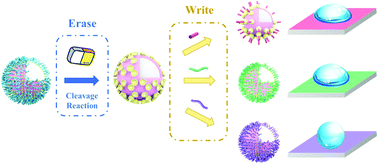Polymer brush-based erasable and rewritable nanostructured particle surfaces†
Abstract
Surface chemical composition and surface properties are two crucial factors in the practical applications of materials. Inventing a simple and versatile method for the control of surface composition and properties is an essential yet challenging job. Herein, an effective approach to the synthesis of erasable and rewritable surface nanostructures is reported. Based on this method, hybrid particles with different surface chemical compositions and tunable surface properties are fabricated. Layer surface structures with PS in the inner layers and PEG at the outer shells are fabricated on silica particles by coassembly of PS brushes and a “free” block copolymer of poly(ethylene glycol) (PEG) and polystyrene (PS) with a disulfide bond at the block point. After cleavage of the disulfides at the layer–shell interface, PEG shells are erased and thiol groups are produced on the PS layers. Reduced glutathione, poly(2-dimethylamino ethyl methacrylate) and poly(methyl methacrylate) are grafted onto the surfaces of the hybrid particles through thiol–disulfide reactions, respectively. Scanning electron microscopy and size exclusion chromatography were used to analyze the surface nanostructures and the erasure of the PEG shells. X-Ray photoelectron spectroscopy, confocal laser scanning microscopy and transmission electron microscopy were employed to demonstrate the writing of the substances on the particle surfaces. Writing with different materials endows the particle surfaces with different surface properties.



 Please wait while we load your content...
Please wait while we load your content...